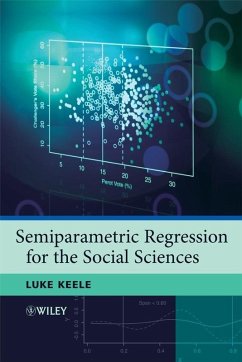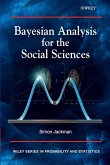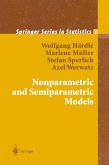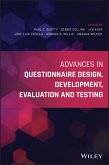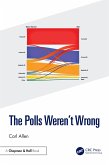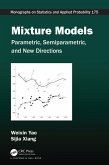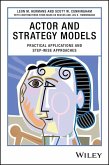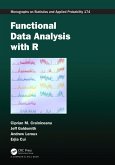Luke John Keele
Semiparametric Regression for the Social Sciences (eBook, PDF)
66,99 €
66,99 €
inkl. MwSt.
Sofort per Download lieferbar

0 °P sammeln
66,99 €
Als Download kaufen

66,99 €
inkl. MwSt.
Sofort per Download lieferbar

0 °P sammeln
Jetzt verschenken
Alle Infos zum eBook verschenken
66,99 €
inkl. MwSt.
Sofort per Download lieferbar
Alle Infos zum eBook verschenken

0 °P sammeln
Luke John Keele
Semiparametric Regression for the Social Sciences (eBook, PDF)
- Format: PDF
- Merkliste
- Auf die Merkliste
- Bewerten Bewerten
- Teilen
- Produkt teilen
- Produkterinnerung
- Produkterinnerung

Bitte loggen Sie sich zunächst in Ihr Kundenkonto ein oder registrieren Sie sich bei
bücher.de, um das eBook-Abo tolino select nutzen zu können.
Hier können Sie sich einloggen
Hier können Sie sich einloggen
Sie sind bereits eingeloggt. Klicken Sie auf 2. tolino select Abo, um fortzufahren.

Bitte loggen Sie sich zunächst in Ihr Kundenkonto ein oder registrieren Sie sich bei bücher.de, um das eBook-Abo tolino select nutzen zu können.
An introductory guide to smoothing techniques, semiparametric estimators, and their related methods, this book describes the methodology via a selection of carefully explained examples and data sets. It also demonstrates the potential of these techniques using detailed empirical examples drawn from the social and political sciences. Each chapter includes exercises and examples and there is a supplementary website containing all the datasets used, as well as computer code, allowing readers to replicate every analysis reported in the book. Includes software for implementing the methods in S-Plus and R.…mehr
- Geräte: PC
- mit Kopierschutz
- eBook Hilfe
- Größe: 2.5MB
Andere Kunden interessierten sich auch für
![Bayesian Analysis for the Social Sciences (eBook, PDF) Bayesian Analysis for the Social Sciences (eBook, PDF)]() Simon JackmanBayesian Analysis for the Social Sciences (eBook, PDF)60,99 €
Simon JackmanBayesian Analysis for the Social Sciences (eBook, PDF)60,99 €![Nonparametric and Semiparametric Models (eBook, PDF) Nonparametric and Semiparametric Models (eBook, PDF)]() Wolfgang Karl HärdleNonparametric and Semiparametric Models (eBook, PDF)137,95 €
Wolfgang Karl HärdleNonparametric and Semiparametric Models (eBook, PDF)137,95 €![Advances in Questionnaire Design, Development, Evaluation and Testing (eBook, PDF) Advances in Questionnaire Design, Development, Evaluation and Testing (eBook, PDF)]() Advances in Questionnaire Design, Development, Evaluation and Testing (eBook, PDF)103,99 €
Advances in Questionnaire Design, Development, Evaluation and Testing (eBook, PDF)103,99 €![The Polls Weren't Wrong (eBook, PDF) The Polls Weren't Wrong (eBook, PDF)]() Carl AllenThe Polls Weren't Wrong (eBook, PDF)41,95 €
Carl AllenThe Polls Weren't Wrong (eBook, PDF)41,95 €![Mixture Models (eBook, PDF) Mixture Models (eBook, PDF)]() Weixin YaoMixture Models (eBook, PDF)52,95 €
Weixin YaoMixture Models (eBook, PDF)52,95 €![Actor and Strategy Models (eBook, PDF) Actor and Strategy Models (eBook, PDF)]() Leon M. HermansActor and Strategy Models (eBook, PDF)80,99 €
Leon M. HermansActor and Strategy Models (eBook, PDF)80,99 €![Functional Data Analysis with R (eBook, PDF) Functional Data Analysis with R (eBook, PDF)]() Ciprian M. CrainiceanuFunctional Data Analysis with R (eBook, PDF)52,95 €
Ciprian M. CrainiceanuFunctional Data Analysis with R (eBook, PDF)52,95 €-
-
-
An introductory guide to smoothing techniques, semiparametric estimators, and their related methods, this book describes the methodology via a selection of carefully explained examples and data sets. It also demonstrates the potential of these techniques using detailed empirical examples drawn from the social and political sciences. Each chapter includes exercises and examples and there is a supplementary website containing all the datasets used, as well as computer code, allowing readers to replicate every analysis reported in the book. Includes software for implementing the methods in S-Plus and R.
Dieser Download kann aus rechtlichen Gründen nur mit Rechnungsadresse in D ausgeliefert werden.
Produktdetails
- Produktdetails
- Verlag: Wiley-Scrivener
- Erscheinungstermin: 15. April 2008
- Englisch
- ISBN-13: 9780470998120
- Artikelnr.: 38216797
- Verlag: Wiley-Scrivener
- Erscheinungstermin: 15. April 2008
- Englisch
- ISBN-13: 9780470998120
- Artikelnr.: 38216797
- Herstellerkennzeichnung Die Herstellerinformationen sind derzeit nicht verfügbar.
Luke J. Keele - Department of Political Science, Ohio State University, US Since acquiring his PhD, Dr Keele has published work in a number of international journals, including papers on this specific topic. He has also taught the material for the proposed book at Ohio State University and presented it at international meetings.Dr Keele is a political scientist by trade but has considerable experience in applying statistical techniques to social science applications.
List of Tables.
List of Figures.
Preface.
1 Introduction: Global versus Local Statistics.
1.1 The Consequences of Ignoring Nonlinearity.
1.2 Power Transformations.
1.3 Nonparametric and Semiparametric Techniques.
1.4 Outline of the Text.
2 Smoothing and Local Regression.
2.1 Simple Smoothing.
2.1.1 Local Averaging.
2.1.2 Kernel Smoothing.
2.2 Local Polynomial Regression.
2.3 Nonparametric Modeling Choices.
2.3.1 The Span.
2.3.2 Polynomial Degree and Weight Function.
2.3.3 A Note on Interpretation.
2.4 Statistical Inference for Local Polynomial Regression.
2.5 Multiple Nonparametric Regression.
2.6 Conclusion.
2.7 Exercises.
3 Splines.
3.1 Simple Regression Splines.
3.1.1 Basis Functions.
3.2 Other Spline Models and Bases.
3.2.1 Quadratic and Cubic Spline Bases.
3.2.2 Natural Splines.
3.2.3 B-splines.
3.2.4 Knot Placement and Numbers.
3.2.5 Comparing Spline Models.
3.3 Splines and Overfitting.
3.3.1 Smoothing Splines.
3.3.2 Splines as Mixed Models.
3.3.3 Final Notes on Smoothing Splines.
3.3.4 Thin Plate Splines.
3.4 Inference for Splines.
3.5 Comparisons and Conclusions.
3.6 Exercises.
4 Automated Smoothing Techniques.
4.1 Span by Cross-Validation.
4.2 Splines and Automated Smoothing.
4.2.1 Estimating Smoothing Through the Likelihood.
4.2.2 Smoothing Splines and Cross-Validation.
4.3 Automated Smoothing in Practice.
4.4 Automated Smoothing Caveats.
4.5 Exercises.
5 Additive and Semiparametric Regression Models.
5.1 Additive Models.
5.2 Semiparametric Regression Models.
5.3 Estimation.
5.3.1 Backfitting.
5.4 Inference.
5.5 Examples.
5.5.1 Congressional Elections.
5.5.2 Feminist Attitudes.
5.6 Discussion.
5.7 Exercises.
6 Generalized Additive Models.
6.1 Generalized Linear Models.
6.2 Estimation of GAMS.
6.3 Statistical Inference.
6.4 Examples.
6.4.1 Logistic Regression: The Liberal Peace.
6.4.2 Ordered Logit: Domestic Violence.
6.4.3 Count Models: Supreme Court Overrides.
6.4.4 Survival Models: Race Riots.
6.5 Discussion.
6.6 Exercises.
7 Extensions of the Semiparametric Regression Model.
7.1 Mixed Models.
7.2 Bayesian Smoothing.
7.3 Propensity Score Matching.
7.4 Conclusion.
8 Bootstrapping.
8.1 Classical Inference.
8.2 Bootstrapping - An Overview.
8.2.1 Bootstrapping.
8.2.2 An Example: Bootstrapping the Mean.
8.2.3 Bootstrapping Regression Models.
8.2.4 An Example: Presidential Elections.
8.3 Bootstrapping Nonparametric and Semiparametric Regression Models.
8.3.1 Bootstrapping Nonparametric Fits.
8.3.2 Bootstrapping Nonlinearity Tests.
8.4 Conclusion.
8.5 Exercises.
9 Epilogue.
Appendix: Software.
Bibliography.
Author Index.
Subject Index.
List of Figures.
Preface.
1 Introduction: Global versus Local Statistics.
1.1 The Consequences of Ignoring Nonlinearity.
1.2 Power Transformations.
1.3 Nonparametric and Semiparametric Techniques.
1.4 Outline of the Text.
2 Smoothing and Local Regression.
2.1 Simple Smoothing.
2.1.1 Local Averaging.
2.1.2 Kernel Smoothing.
2.2 Local Polynomial Regression.
2.3 Nonparametric Modeling Choices.
2.3.1 The Span.
2.3.2 Polynomial Degree and Weight Function.
2.3.3 A Note on Interpretation.
2.4 Statistical Inference for Local Polynomial Regression.
2.5 Multiple Nonparametric Regression.
2.6 Conclusion.
2.7 Exercises.
3 Splines.
3.1 Simple Regression Splines.
3.1.1 Basis Functions.
3.2 Other Spline Models and Bases.
3.2.1 Quadratic and Cubic Spline Bases.
3.2.2 Natural Splines.
3.2.3 B-splines.
3.2.4 Knot Placement and Numbers.
3.2.5 Comparing Spline Models.
3.3 Splines and Overfitting.
3.3.1 Smoothing Splines.
3.3.2 Splines as Mixed Models.
3.3.3 Final Notes on Smoothing Splines.
3.3.4 Thin Plate Splines.
3.4 Inference for Splines.
3.5 Comparisons and Conclusions.
3.6 Exercises.
4 Automated Smoothing Techniques.
4.1 Span by Cross-Validation.
4.2 Splines and Automated Smoothing.
4.2.1 Estimating Smoothing Through the Likelihood.
4.2.2 Smoothing Splines and Cross-Validation.
4.3 Automated Smoothing in Practice.
4.4 Automated Smoothing Caveats.
4.5 Exercises.
5 Additive and Semiparametric Regression Models.
5.1 Additive Models.
5.2 Semiparametric Regression Models.
5.3 Estimation.
5.3.1 Backfitting.
5.4 Inference.
5.5 Examples.
5.5.1 Congressional Elections.
5.5.2 Feminist Attitudes.
5.6 Discussion.
5.7 Exercises.
6 Generalized Additive Models.
6.1 Generalized Linear Models.
6.2 Estimation of GAMS.
6.3 Statistical Inference.
6.4 Examples.
6.4.1 Logistic Regression: The Liberal Peace.
6.4.2 Ordered Logit: Domestic Violence.
6.4.3 Count Models: Supreme Court Overrides.
6.4.4 Survival Models: Race Riots.
6.5 Discussion.
6.6 Exercises.
7 Extensions of the Semiparametric Regression Model.
7.1 Mixed Models.
7.2 Bayesian Smoothing.
7.3 Propensity Score Matching.
7.4 Conclusion.
8 Bootstrapping.
8.1 Classical Inference.
8.2 Bootstrapping - An Overview.
8.2.1 Bootstrapping.
8.2.2 An Example: Bootstrapping the Mean.
8.2.3 Bootstrapping Regression Models.
8.2.4 An Example: Presidential Elections.
8.3 Bootstrapping Nonparametric and Semiparametric Regression Models.
8.3.1 Bootstrapping Nonparametric Fits.
8.3.2 Bootstrapping Nonlinearity Tests.
8.4 Conclusion.
8.5 Exercises.
9 Epilogue.
Appendix: Software.
Bibliography.
Author Index.
Subject Index.
List of Tables.
List of Figures.
Preface.
1 Introduction: Global versus Local Statistics.
1.1 The Consequences of Ignoring Nonlinearity.
1.2 Power Transformations.
1.3 Nonparametric and Semiparametric Techniques.
1.4 Outline of the Text.
2 Smoothing and Local Regression.
2.1 Simple Smoothing.
2.1.1 Local Averaging.
2.1.2 Kernel Smoothing.
2.2 Local Polynomial Regression.
2.3 Nonparametric Modeling Choices.
2.3.1 The Span.
2.3.2 Polynomial Degree and Weight Function.
2.3.3 A Note on Interpretation.
2.4 Statistical Inference for Local Polynomial Regression.
2.5 Multiple Nonparametric Regression.
2.6 Conclusion.
2.7 Exercises.
3 Splines.
3.1 Simple Regression Splines.
3.1.1 Basis Functions.
3.2 Other Spline Models and Bases.
3.2.1 Quadratic and Cubic Spline Bases.
3.2.2 Natural Splines.
3.2.3 B-splines.
3.2.4 Knot Placement and Numbers.
3.2.5 Comparing Spline Models.
3.3 Splines and Overfitting.
3.3.1 Smoothing Splines.
3.3.2 Splines as Mixed Models.
3.3.3 Final Notes on Smoothing Splines.
3.3.4 Thin Plate Splines.
3.4 Inference for Splines.
3.5 Comparisons and Conclusions.
3.6 Exercises.
4 Automated Smoothing Techniques.
4.1 Span by Cross-Validation.
4.2 Splines and Automated Smoothing.
4.2.1 Estimating Smoothing Through the Likelihood.
4.2.2 Smoothing Splines and Cross-Validation.
4.3 Automated Smoothing in Practice.
4.4 Automated Smoothing Caveats.
4.5 Exercises.
5 Additive and Semiparametric Regression Models.
5.1 Additive Models.
5.2 Semiparametric Regression Models.
5.3 Estimation.
5.3.1 Backfitting.
5.4 Inference.
5.5 Examples.
5.5.1 Congressional Elections.
5.5.2 Feminist Attitudes.
5.6 Discussion.
5.7 Exercises.
6 Generalized Additive Models.
6.1 Generalized Linear Models.
6.2 Estimation of GAMS.
6.3 Statistical Inference.
6.4 Examples.
6.4.1 Logistic Regression: The Liberal Peace.
6.4.2 Ordered Logit: Domestic Violence.
6.4.3 Count Models: Supreme Court Overrides.
6.4.4 Survival Models: Race Riots.
6.5 Discussion.
6.6 Exercises.
7 Extensions of the Semiparametric Regression Model.
7.1 Mixed Models.
7.2 Bayesian Smoothing.
7.3 Propensity Score Matching.
7.4 Conclusion.
8 Bootstrapping.
8.1 Classical Inference.
8.2 Bootstrapping - An Overview.
8.2.1 Bootstrapping.
8.2.2 An Example: Bootstrapping the Mean.
8.2.3 Bootstrapping Regression Models.
8.2.4 An Example: Presidential Elections.
8.3 Bootstrapping Nonparametric and Semiparametric Regression Models.
8.3.1 Bootstrapping Nonparametric Fits.
8.3.2 Bootstrapping Nonlinearity Tests.
8.4 Conclusion.
8.5 Exercises.
9 Epilogue.
Appendix: Software.
Bibliography.
Author Index.
Subject Index.
List of Figures.
Preface.
1 Introduction: Global versus Local Statistics.
1.1 The Consequences of Ignoring Nonlinearity.
1.2 Power Transformations.
1.3 Nonparametric and Semiparametric Techniques.
1.4 Outline of the Text.
2 Smoothing and Local Regression.
2.1 Simple Smoothing.
2.1.1 Local Averaging.
2.1.2 Kernel Smoothing.
2.2 Local Polynomial Regression.
2.3 Nonparametric Modeling Choices.
2.3.1 The Span.
2.3.2 Polynomial Degree and Weight Function.
2.3.3 A Note on Interpretation.
2.4 Statistical Inference for Local Polynomial Regression.
2.5 Multiple Nonparametric Regression.
2.6 Conclusion.
2.7 Exercises.
3 Splines.
3.1 Simple Regression Splines.
3.1.1 Basis Functions.
3.2 Other Spline Models and Bases.
3.2.1 Quadratic and Cubic Spline Bases.
3.2.2 Natural Splines.
3.2.3 B-splines.
3.2.4 Knot Placement and Numbers.
3.2.5 Comparing Spline Models.
3.3 Splines and Overfitting.
3.3.1 Smoothing Splines.
3.3.2 Splines as Mixed Models.
3.3.3 Final Notes on Smoothing Splines.
3.3.4 Thin Plate Splines.
3.4 Inference for Splines.
3.5 Comparisons and Conclusions.
3.6 Exercises.
4 Automated Smoothing Techniques.
4.1 Span by Cross-Validation.
4.2 Splines and Automated Smoothing.
4.2.1 Estimating Smoothing Through the Likelihood.
4.2.2 Smoothing Splines and Cross-Validation.
4.3 Automated Smoothing in Practice.
4.4 Automated Smoothing Caveats.
4.5 Exercises.
5 Additive and Semiparametric Regression Models.
5.1 Additive Models.
5.2 Semiparametric Regression Models.
5.3 Estimation.
5.3.1 Backfitting.
5.4 Inference.
5.5 Examples.
5.5.1 Congressional Elections.
5.5.2 Feminist Attitudes.
5.6 Discussion.
5.7 Exercises.
6 Generalized Additive Models.
6.1 Generalized Linear Models.
6.2 Estimation of GAMS.
6.3 Statistical Inference.
6.4 Examples.
6.4.1 Logistic Regression: The Liberal Peace.
6.4.2 Ordered Logit: Domestic Violence.
6.4.3 Count Models: Supreme Court Overrides.
6.4.4 Survival Models: Race Riots.
6.5 Discussion.
6.6 Exercises.
7 Extensions of the Semiparametric Regression Model.
7.1 Mixed Models.
7.2 Bayesian Smoothing.
7.3 Propensity Score Matching.
7.4 Conclusion.
8 Bootstrapping.
8.1 Classical Inference.
8.2 Bootstrapping - An Overview.
8.2.1 Bootstrapping.
8.2.2 An Example: Bootstrapping the Mean.
8.2.3 Bootstrapping Regression Models.
8.2.4 An Example: Presidential Elections.
8.3 Bootstrapping Nonparametric and Semiparametric Regression Models.
8.3.1 Bootstrapping Nonparametric Fits.
8.3.2 Bootstrapping Nonlinearity Tests.
8.4 Conclusion.
8.5 Exercises.
9 Epilogue.
Appendix: Software.
Bibliography.
Author Index.
Subject Index.
